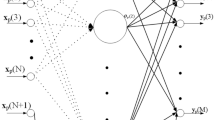Abstract
Radial basis function (RBF) networks are used in many applications, e.g. for pattern classification or nonlinear regression. Typically, either stochastic, iterative training algorithms (e.g. gradient-based or second-order techniques) or clustering methods in combination with a linear optimisation technique (e.g. c-means and singular value decomposition for a linear least-squares problem) are applied to find the parameters (centres, radii and weights) of an RBF network. This article points out the advantages of a combination of the two approaches and describes a modification of the standard c-means algorithm that leads to a linear least-squares problem for which solvability can be guaranteed. The first idea may lead to significant improvements concerning the training time as well as the approximation and generalisation properties of the networks. In the particular application problem investigated here (intrusion detection in computer networks), the overall training time could be reduced by about 29% and the error rate could be reduced by about 74%. The second idea rises the reliability of the training procedure at no additional costs (regarding both, run time and quality of results).
Access this chapter
Tax calculation will be finalised at checkout
Purchases are for personal use only
Preview
Unable to display preview. Download preview PDF.
Similar content being viewed by others
References
Bishop, C.M.: Neural Networks for Pattern Recognition. Clarendon Press, Oxford (1995)
Haykin, S.: Neural Networks — A Comprehensive Foundation. Macmillan College Publishing Company, New York (1994)
Poggio, T., Girosi, F.: A theory of networks for approximation and learning. A.I. Memo No. 1140, C.B.I.P. Paper No. 31, Mass. Inst. of Tech. — Artif. Intell. Lab. & Center for Biol. Information Processing — Whitaker College (1989)
**, Y., von Seelen, W., Sendhoff, B.: Extracting interpretable fuzzy rules from RBF neural networks. Int. Rep. 2000–02, Institut für Neuroinformatik (INF), Ruhr-Universität Bochum (2000)
Moody, J., Darken, C.J.: Fast learning in networks of locally-tuned processing units. In: Neural Computation. Vol. 1. (1989) 281–294
Kiernan, I., Mason, J.D., Warwick, K.: Robust initialisation of gaussian radial basis function networks using partitioned k-means clustering. In: Electronics Letters. Vol. 32(7). (1996) 671–673
Brizzotti, M.M., Carvalho, A.C.P.L.F.: The influence of clustering techniques in the RBF networks generalization. In: Proc. of the 7th Int. Conf. on Image Processing and its Applications, Manchester. Vol. 1. (1999) 87–92
Hoya, T., Constantinides, A.: An heuristic pattern correction scheme for GRNNs and its application to speech recognition. In: Proc. of the 1998 IEEE Signal Processing Society Workshop Neural Networks for Signal Processing VIII, Cambridge. (1998) 351–359
De Castro, M.C.F., De Castro, F.C.C., Arantes, D.S.: RBF neural networks with centers assignment via Karhunen-Loève transform. In: Int. Joint Conf. on Neural Networks (IJCNN’ 99), Washington. Vol. 2. (1999) 1265–1270
Shimoji, S., Lee, S.: Data clustering with entropical scheduling. In: Int. Conf. on Neural Networks, Orlando. Vol. 4. (1994) 2423–2428
Musavi, M.T., Ahmed, W., Chan, K.H., Faris, K.B., Hummels, D.M.: On the training of radial basis function classifiers. In: Neural Networks. Vol. 5. (1992) 595–603
Mak, M.W., Cho, K.W.: Genetic evolution of radial basis function centers for pattern classification. In: Int. Joint Conf. on Neural Networks (IJCNN’ 98), Anchorage. Vol. 1. (1998) 669–673
Whitehead, B., Choate, T.D.: Cooperative-competitive genetic evolution of radial basis function centers and widths for time series prediction. In: IEEE Trans. on Neural Networks. Vol. 7(4). (1996) 869–880
Billings, S.A., Zheng, G.L.: Radial basis function network configuration using genetic algorithms. In: Neural Networks. Vol. 8(6). (1998) 877–890
Ghinelli, B.M.G., Bennett, J.C.: The application of artificial neural networks and standard statistical methods to SAR image classification. In: IEEE Int. Geoscience and Remote Sensing (IGARSS’ 97), Singapore. Vol. 3. (1997) 1211–1213
Whitehead, B., Choate, T.D.: Evolving space-filling curves to distribute radial basis functions over an input space. In: IEEE Trans. on Neural Networks. Vol. 5(1). (1994) 15–23
Wheeler, K.R., Dhawan, A.P.: Ssme parameter estimation using radial basis function neural networks. In: Int. Conf. on Neural Networks, Orlando. Vol. 5. (1994) 3352–3357
Björck, Å.: Numerical Methods for Least Squares Problems. SIAM, Philadelphia (1996)
Shepherd, A.J.: Second Order Methods for Neural Networks — Fast and Reliable Training Methods for Multi-Layer Perceptrons. Springer-Verlag, London (1997)
Mao, K.Z.: RBF neural network center selection based on Fisher ratio class separability measure. In: IEEE Trans. on Neural Networks. Vol. 13(5). (2002) 1211–1217
Berthold, M.R., Feldbusch, F.: Ein Trainingsverfahren für Radial Basis Function Netzwerke mit dynamischer Selektion der Zentren und Adaption der Radii. In Reusch, B., ed.: Fuzzy Logik — Theorie und Praxis. (1994) 78–85
Riedmiller, M.: RPROP — Description and implementation details. Tech. Rep., Univ. Karlsruhe (1994)
Knuth, D.E.: The Art of Computer Programming. 3rd edn. Addison Wesley Longman (1998)
Cohen, S., Intrator, N.: Global optimization of RBF networks (2000) (submitted to IEEE Trans. on Neural Networks).
Golub, G.H., van Loan, C.F.: Matrix Computations. 3 edn. Johns Hopkins studies in the mathematical sciences. Johns Hopkins Univ. Press, Baltimore (1996)
Hofmann, A.: Einsatz von Soft-Computing-Verfahren zur Erkennung von Angriffen auf Rechnernetze. Master’s thesis, University of Passau (2002)
Author information
Authors and Affiliations
Editor information
Editors and Affiliations
Rights and permissions
Copyright information
© 2003 Springer-Verlag Berlin Heidelberg
About this paper
Cite this paper
Buchtala, O., Hofmann, A., Sick, B. (2003). Fast and Efficient Training of RBF Networks. In: Kaynak, O., Alpaydin, E., Oja, E., Xu, L. (eds) Artificial Neural Networks and Neural Information Processing — ICANN/ICONIP 2003. ICANN ICONIP 2003 2003. Lecture Notes in Computer Science, vol 2714. Springer, Berlin, Heidelberg. https://doi.org/10.1007/3-540-44989-2_6
Download citation
DOI: https://doi.org/10.1007/3-540-44989-2_6
Published:
Publisher Name: Springer, Berlin, Heidelberg
Print ISBN: 978-3-540-40408-8
Online ISBN: 978-3-540-44989-8
eBook Packages: Springer Book Archive




